History
- Introduction
- The beginnings - Art Nouveau & Red Propaganda (1895 - 1919)
- Art Deco & Modernism (1920 - 1944)
- The distinctive poster art of a short-lived democracy (1945 - 1949)
- Socialist Realism and the continuity of the modern poster (1950 - 1955)
- A cavalcade of styles & techniques (1956 - 1970)
- The low-culture and the neo avantgarde (1971 - 1990)
The Low-Culture and the Neo Avant-garde (1971 - 1990)
Take a look at our inventory from this period by: clicking here.
In the years between 1970 and 1990, the growth of poster design continued. Still many different styles and techniques coexisted, which resulted in a pleasant variety. The soft dictatorship of the 1960s became even softer and the critical voices against the socialist system got louder. The outside world got more and more chance to permeate through the Iron Curtain: western movies, fashion, music and all aspects of popular culture had a profound effect on Hungarian society.
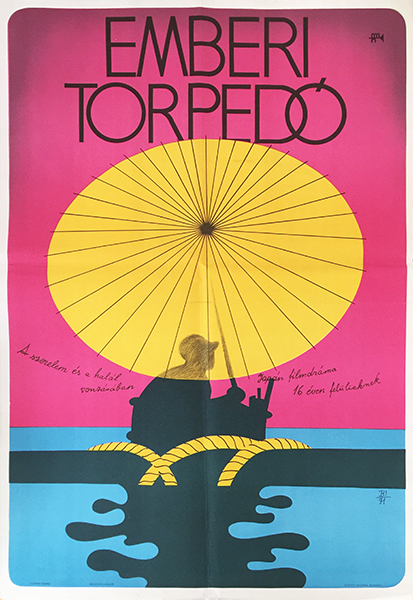
Istvan Balogh - Nikudan The Human Bullet hungarian movie poster
The history of the Hungarian neo avant-garde started at the end of the 1960s, with the Iparterv (“Industry-planning”) group formed in 1967. The neo avant-garde artists worked underground, since they were banned due to the criticism of the system displayed on their exhibitions and performances. The East-Central European neo avant-garde took the parallel western contemporary tendencies as their starting point, but it was profoundly different because of its political nature. While Conceptualism in the Western world raised questions about the nature of art, and focused on philosophical issues, the eastern conceptual art criticized the system, and in most cases had strong political undertones. The criticism of the socialist system was combined in this art form with investigating the possibilities and boundaries of artistic expression; thus became the question of art the question of freedom. Following international trends, the neo avant-garde produced new forms and mediums of art: like Action Art, Performance Art, Installation Art, Land Art, Mail Art or Conceptual Art. Many of these mediums are in fact art forms without any object.
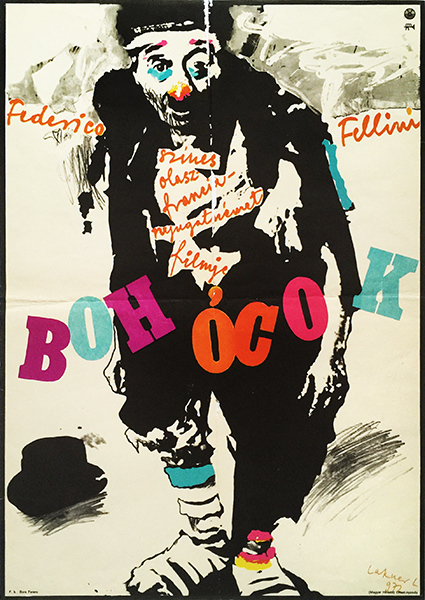
Laszlo Lakner - Fellini Clowns 1972 Hungarian movie poster
These new forms had an implicit effect on poster art. While neo avant-garde artworks were accessible only for a small audience, the posters appeared on the streets and communicated with the whole society. This turned them into an important channel for the newest art tendencies. Many important neo avant-garde artists appreciated the poster genre, and regarded it as a special and independent art form. László Lakner’s strong conceptual attitude is visible on his exhibition posters.
Conceptualism defines the works of Károly Schmal, who started his career in the late 1960s. Schmal almost exclusively designed cultural posters; all of them have a special, philosophical atmosphere. He often used self-made photographs of abstract still-lifess created by himself. His exhibition posters raise questions about the physical and theoretical meaning and existence of artworks, such as the posters for the “Month of Museums and Monuments”. A somewhat similar conceptual approach appears in the works of Sándor Pinczehelyi (for example: poster for the Biennale of Plastic Art). His works (besides the posters, his paintings, objects and photo-works as well) often raised political and social questions, which usually inclueded the critics of the system.
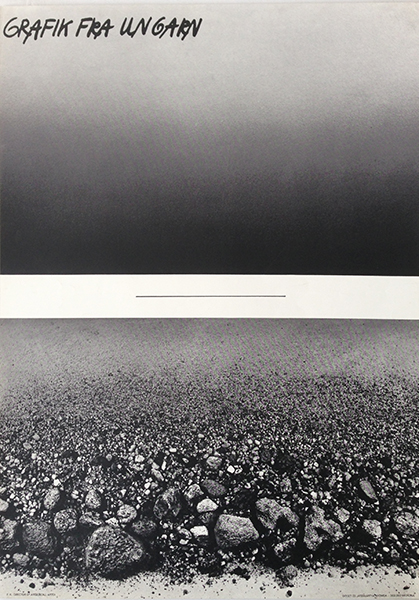
Karoly Schmal - Grafik Fra Ungarn
Besides the still active Papp-group, new artist groups were formed: Quintett (members: István Bakos, Kálmán Molnár, József Pecsenke, Károly Schmal, Emőke Simonyi) and Perspektíva (Perspective) (members: István Bakos, Margit Balla, István Bányai, András Felvidéki, Tibor Helényi, György Kemény, Kálmán Molnár, Károly Schmal).
Artists with different styles and philosophies gathered in these groups, with the common aim of producing great poster art. György Kemény designed a poster for the exhibition of the Perspective group in 1978, for which he used a drawing technique, which is a conceptual poster that shows a postmodern attitude: it questions the traditions of perspective and it criticizes the everyday life in socialism, with the image of a very cheap and common product, the Medvesajt (Bear cheese).
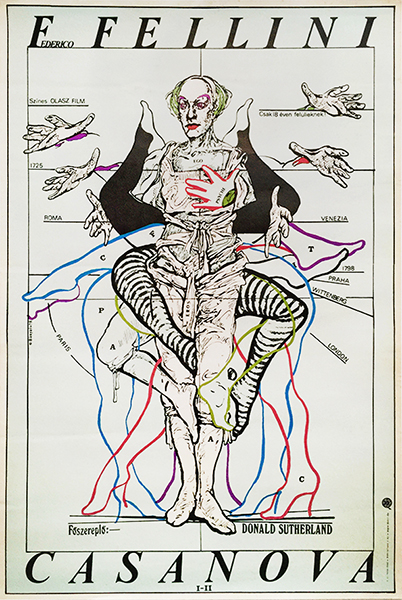
Istvan Banyai - Casanova 1978 Hungarian movie poster
Two very talented young artists appeared in the Perspective group, who introduced a new visual language in poster art: Tibor Helényi and István Bányai. In 1974, the Papp-group gave an opportunity for the young artists to exhibit their works. The poster for the exhibition titled 70x100, was designed by Helényi, and it shows the style of the new generation: the cool typographic design is replaced by a grotesque and figurative style. Helényi designed the poster of the Studio exhibition in 1967 in the same manner; it shows the head of a shouting young man. Helényi’s posters showcase his brilliant drawing skills. He liked to depict distorted figures and strange perspectives. His art has two basic sources: the popular culture of the day (comics, science-fiction movies, etc.) and the renaissance, mannerist and baroque painting. The latter appears more pronounced on his exhibition posters; he reused classic motifs as elements of a montage, combined with strange foreshortening. Both Helényi's poster art, and the baroque peinture attempts to effect the viewer; Helényi was inspired by the old painter's art of illusion. (Helényi was also a very active and acknowledged painter and illustrator). The views and foreshortenings appear on his movie posters as well, but he was more inspired by the popular visual culture. This style perfectly fitted the posters of the cult films of the era (for example: Alien, the Star Wars series, Encounters of the third kind, Robocop etc.). He created picturesque visions about utopistic worlds.
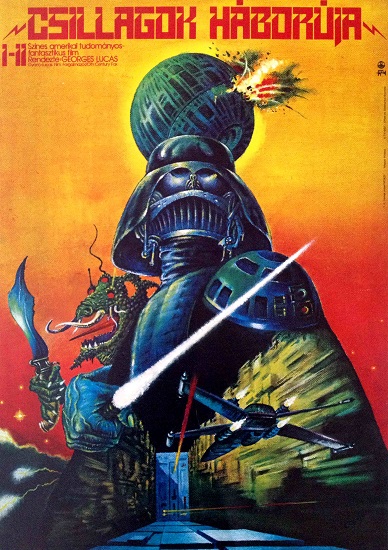
Tibor Helenyi - Star Wars: A New Hope 1979 Hungarian movie poster
Another outstanding talent of this period is István Bányai, who was also member of the Perspective group. He consciously used trash elements in his poster designs, and imported motifs from everyday life’s banal visual world. Besides comics and pop art, his posters show the influences of early modern art; he often incorporated elements of classic artworks into his poster designs, for example he used Manet’s Olympia for his movie poster “How to forget the love of our life” (Hogyan felejtsük el életünk legnagyobb szerelmét). On some of his designs the decorative attitude of the Art Nouveau can be felt, which is mixed with Pop Art, the visual world of comics, and the low culture. The images of distorted figures, especially on his movie posters demonstrate his brilliant drawing skills. The traditions of graphic art (scientific illustrations of the baroque era) are reflected on his poster for Fellini’s Casanova. Bányai emmigrated to the United States in the mid-1980's and became one of the most influential illustrator. (He frequently designs covers for The New Yorker, and other magazines, his book Zoom became a worldwide success).
András Felvidéki was Helényi's close friend and school mate, later he also became a very talented and important artist, who created numerous outstanding posters. His drawing style is close to Helényi's and Bányai's. Comics, scienece fiction and tnedencies of the contemporary painting were also influential sources for his art. Felvidéki's unique drawing skills are apparent in his spectacular cultural and movie posters. Besides his friend Helényi, he also designed a poster for Star Wars New Hope - both outdtanding posters were published and displayed on the streets. His surreal visions took shape thanks to his detailed and spectacular drawings; this approach is visible on his movie posters, like The Towering Inferno. Felvidéki is also a very active and talented illustrator.
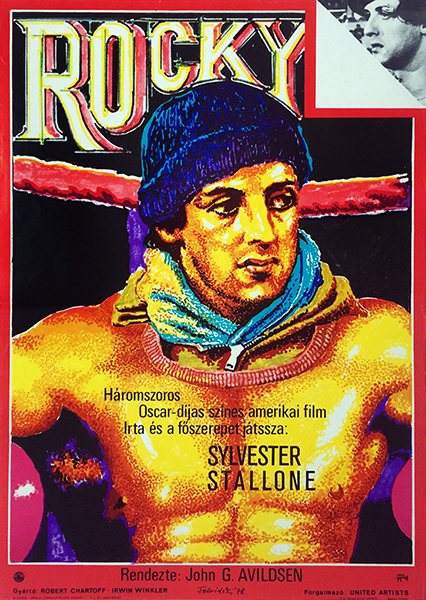
Andras Felvideki - Rocky 1978 hungarian movie poster
In the 1980s a new tendency developed in Hungarian art, a local version of Transavantgarde, which was named “New Sensibility” (the term was coined by Lóránt Hegyi, an art critic). Similarly to international trends, some of the Hungarian painters turned away from the constantly renewing and scandalizing attitude of avant-garde and returned to traditional painting processes. This resulted in an emancipated, colourful, spectacular painting stlye, in which the brushwork and the original marks of the artists were the most important. This tendency has appeared in poster art as well: strong gestured drawings on Schmal’s photographic compositions, Pinczehelyi also drew on his photographs, while György Kemény made colourful expressive marker drawings for exhibition posters (for example: “Frissen festve”). Some artists painted the posters with oil paint or tempera; the surrealistic poster designs of Balogh and Darvas are good examples. The eighties brought not only a new painting style, but the revival of underground music life, which was combined with the emergence of various subcultures.
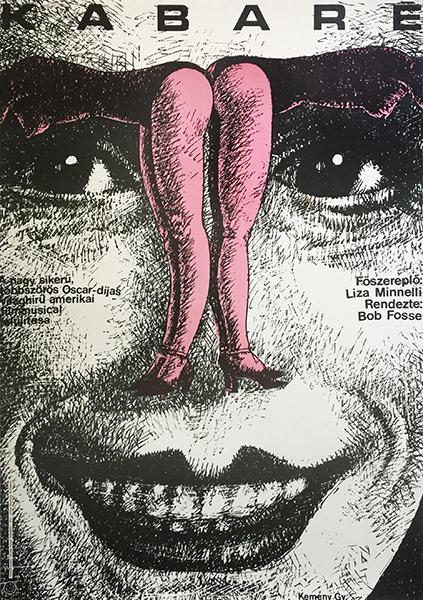
Gyorgy Kemeny - Cabaret Liza Minnelli film movie poster 1973 Hungarian
The slow decay of the communist system brought several critical and rebelling music groups to life, (among them the A.E. Bizottság - Comittee of A(lbert) E(instein)), which was formed by painters, and which had multifarious artistic activity. In this changing world a fresh, ironic, critical and humorous art appeared: music, fine art and performance art which was inspired by popular culture and avoided the official institutions of art. However, the underground cultural life didn’t only manifest in the criticism of the system; it also used the hypocritical image of the American ideal life as a motif. The art of the new generation was characterized by the critical neo-dadaism and a sarcastic tone.The posters for the underground concerts were designed by András Wahorn, György Bp. Szabó and others, and they represented a new, extravagant visual language. They emphasized the triviality of the material culture, and rived the banal objects off their original context. These kinds of images often carried the voice of criticism towards society.
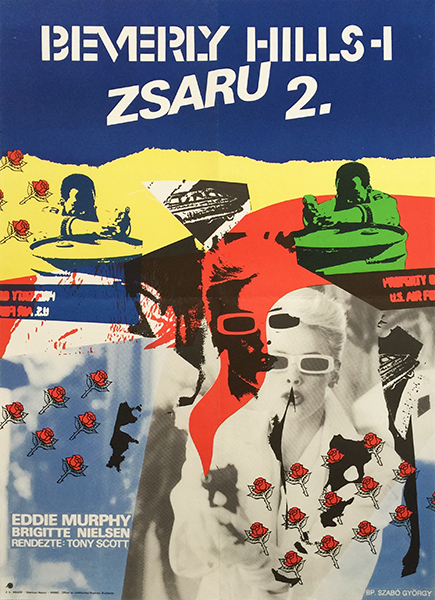
Gyorgy Bp. Szabo - Beverly Hills Cop 2 1989 Hungarian movie poster
In 1987, a new group was formed by poster artists, called DOPP (after the names of the members: Krzystof Ducki, István Orosz, Sándor Pinczehelyi, Péter Pócs). They all are very different artists: Ducki is the representative of the clean but humorous or grotesque Polish poster design in Hungary, Orosz imported the visual world of etchings and engravings into poster design, Pinczehelyi was a neo avant-garde artist, working with provocative montages, while Pócs made painted plasticine objects with a background and took pictures of them, which produced surrealist compositions. They all played an active role in the democratic transition of Hungary in 1989 with their posters.
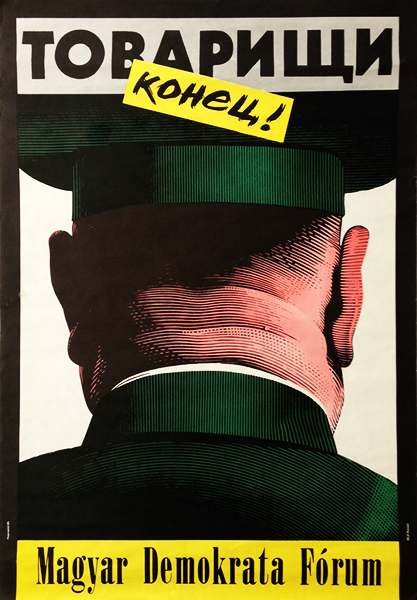
Istvan Orosz - Comrades it's over! Hungarian Democratic Forum
Many great political posters were published for the regime change in 1989 and for the first election in 1990. One of the most famous Hungarian poster is Orosz’s “Tovaristchi Koniec” (Comrades, it’s over!), which shows the nape of a Russian officer in uniform, which embodied everything that Hungary wanted to get rid of. Ducki found a clever symbol in the vampire denture in a glass of water that represented the communist state police, called “Munkásőrség” (Worker Guard).
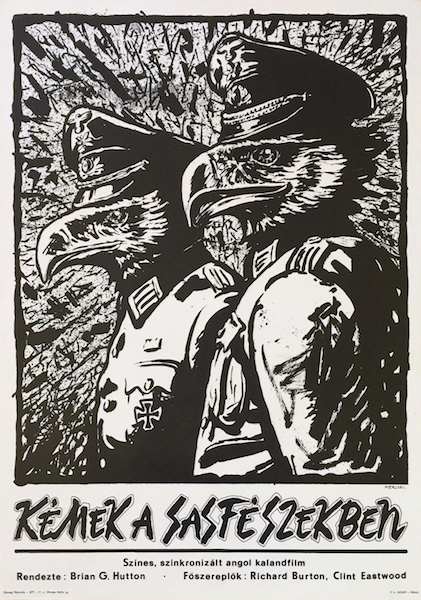
Peter Merczel - Where Eagles Dare 1988 Hungarian vintage first release movie poster
In the 1980s old forms were filled by new contents, and the surrealist and grotesque attitude made the poster genre exciting. Simon Koppány for instance showed bitter humor combined with the style of children’s book illustrations on his posters for official holidays (Women’s Day, Children’s Day). This was the time, when József Árendás started his career. He concentrated mostly on theatre posters, and developed a very unique style. András Alapfy, Gábor Gyárfás, Nándor Hérics, Mária Hodosi, István Kulinyi, András Andor, Jenő Tamás Éri, Gábor Berta, Tamás Futó, István Faragó, Zoltán Herpai, Péter Nagy, and many more young artists design the last great posters.
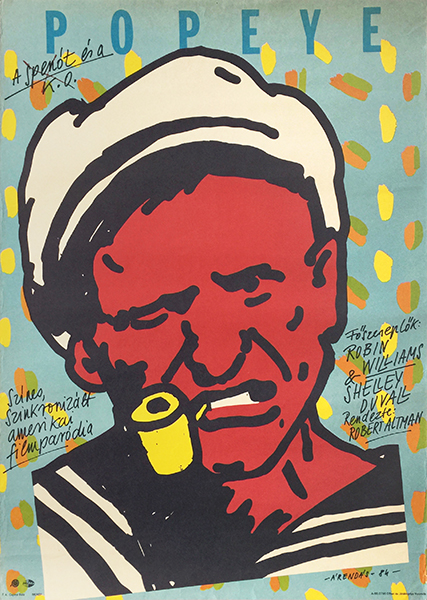
Jozsef Arendas - Popeye Robin Williams 1986 hungarian movie poster
The 1970s and 1980s were the last two decades of the second great golden age of Hungarian poster art, a very colorful era with numerous styles. Unique and different artists made sure that poster art was in a state of endless renewal. The progressive political thaw of the socialist system gave a liberating feeling to the artists: the posters became more and more critical, humorous, sarcastic and grotesque. The end of the socialist era brought one last wave of great political posters in Hungary, and by 1990, the artistic poster has almost completely disappeared.
Take a look at our inventory from this period by: clicking here.